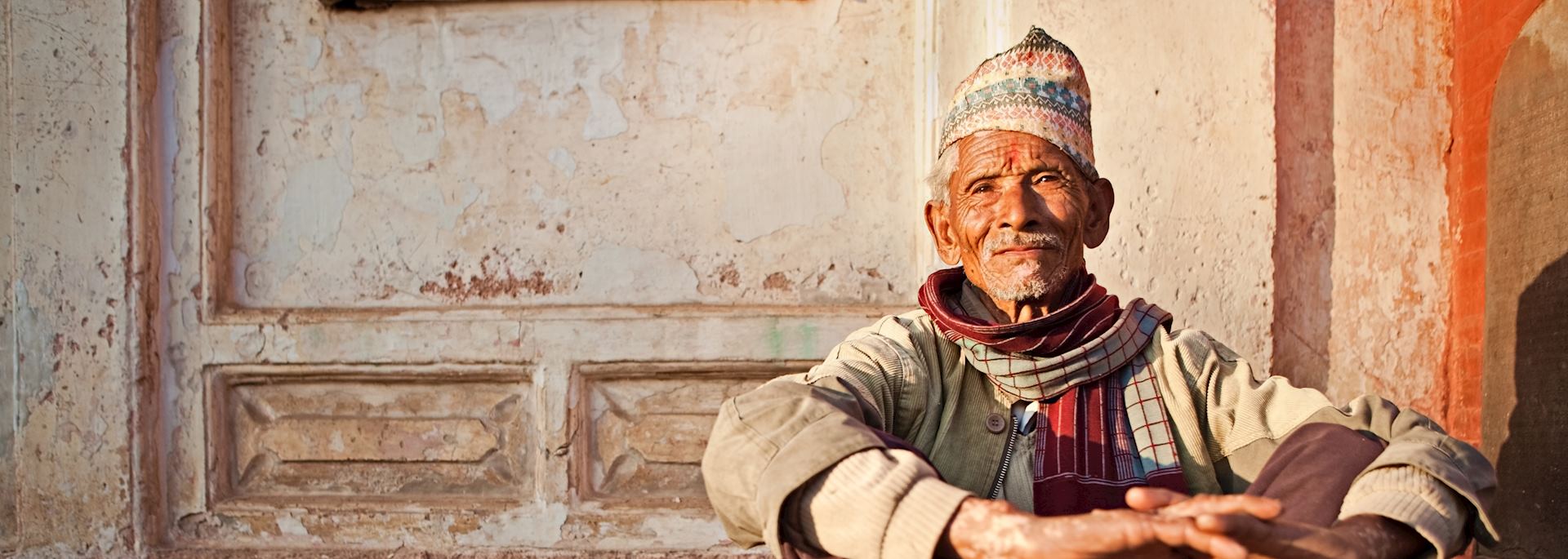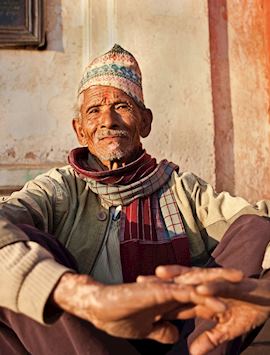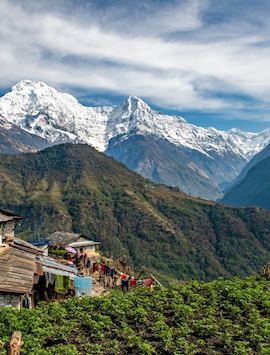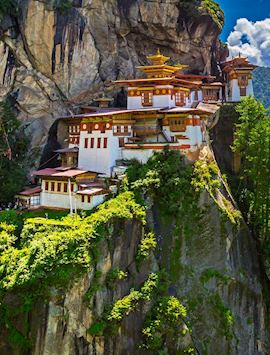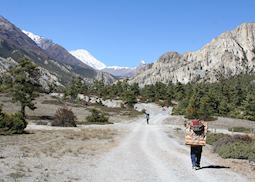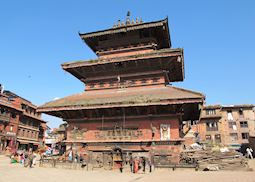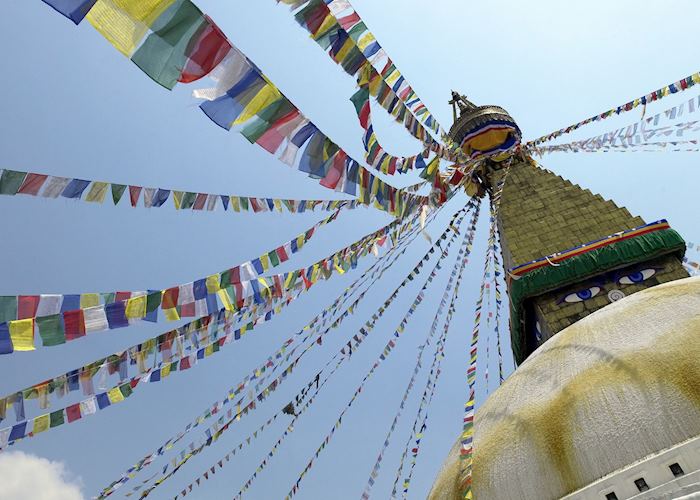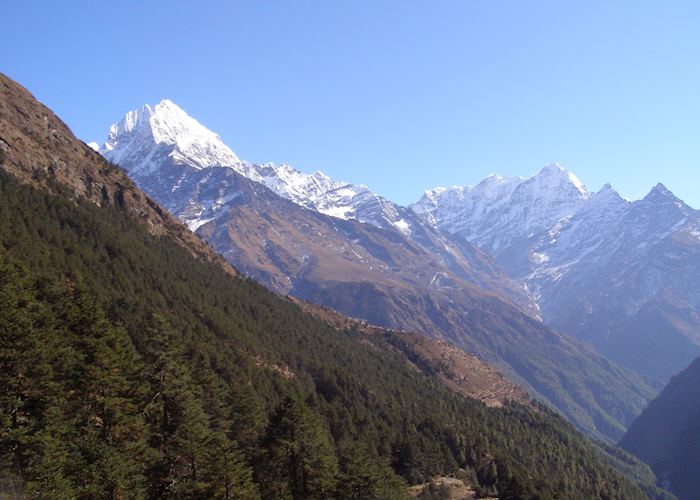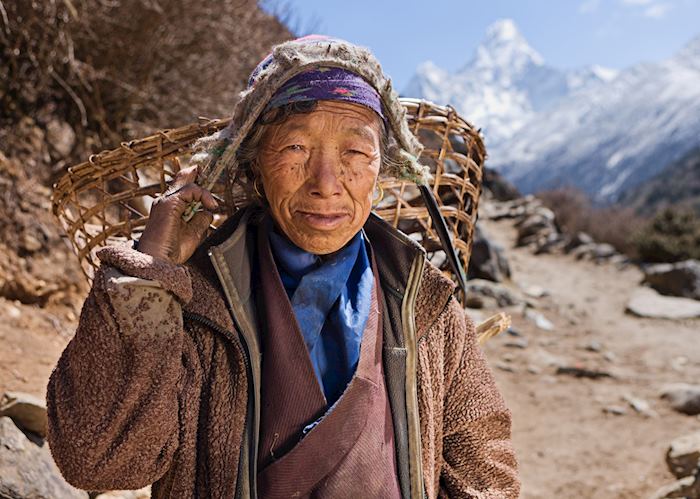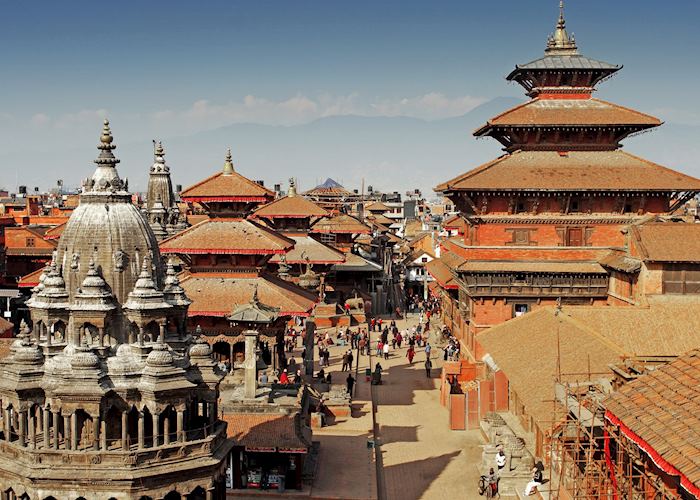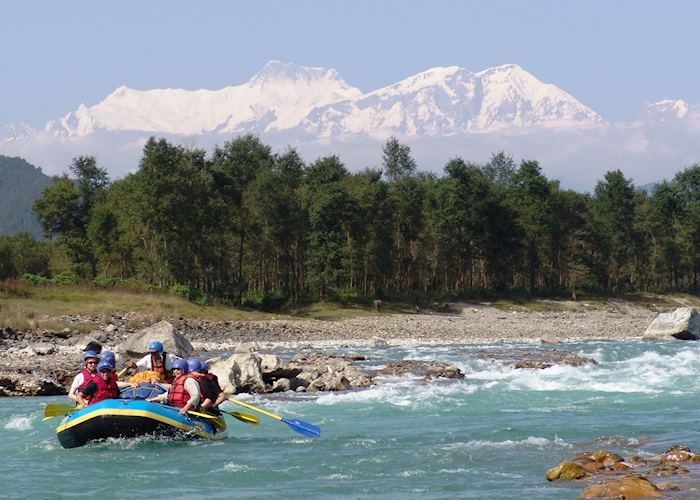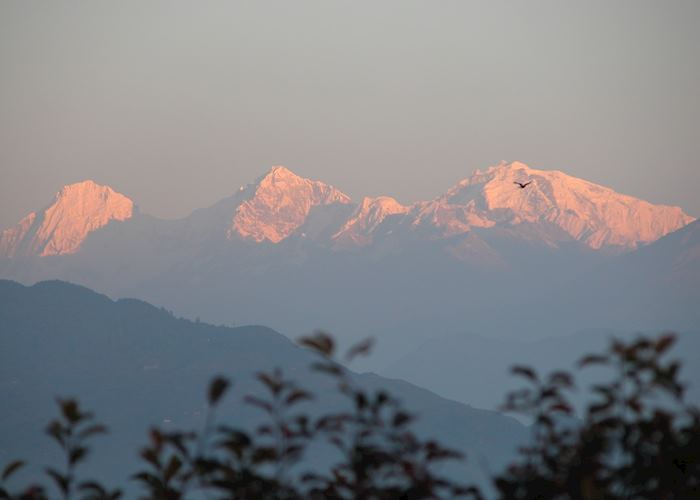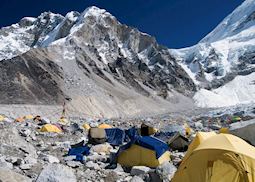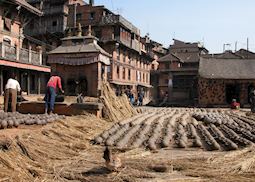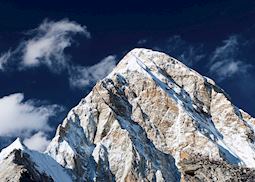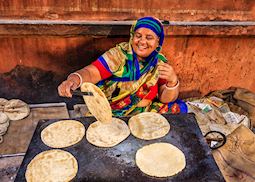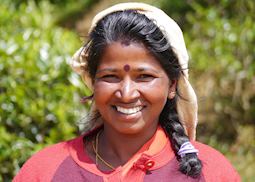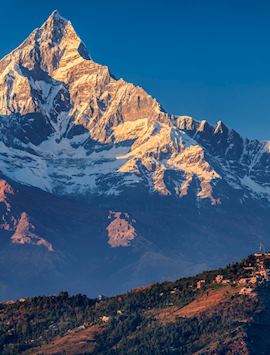
With Mount Everest straddling its border, rare one-horned rhino roaming its jungles and pagodas studding its valleys, the tiny mountain kingdom of Nepal has an almost mythical quality. You don’t have to be an elite mountaineer to explore here, and our specialists can explain the wide variety of trekking options available, as well as experiences beyond the mountains, to shape a tailor-made holiday to Nepal that suits your interests.
Temples, palaces and pilgrimage sites line the Kathmandu Valley, while the capital itself presents you with an assortment of spice bazaars, shrines and artisan workshops. Chitwan National Park is defined by river plains and jungle where Bengal tigers and gharial crocodiles live. In-between you’ll find medieval villages with elaborate Newari mansions and narrow cobbled streets. This is all watched over by the ever-present Annapurna and Everest ranges that form the backbone of the country.
Suggested tours for Nepal
These tours give you a starting point for what your holiday to Nepal could entail. Treat them as inspiration, as each trip is created uniquely for you.
Suggested activities for Nepal
Whatever your interests, our specialists will build activities into your trip that connect to how you want to experience Nepal.
-
Nepal trekking in Annapurna ![Trekking in the Annapurnas]()
Nepal trekking in Annapurna
AnnapurnaNepal trekking in Annapurna
From easy half-day strolls to challenging week-long treks, Nepal’s mountains offer a host of hiking options. In fact, it’s the only way to see much of the country. Here, we outline a few of the options you might choose.
View details -
Boudha Stupa & Pashupatinath ![Sadhus, Pashupatinath, Kathmandu]()
Boudha Stupa & Pashupatinath
KathmanduBoudha Stupa & Pashupatinath
Drive a short distance from Kathmandu to Boudhanath where you will see one of the largest stupas in Nepal. A small Tibetan settlement has developed around this important religious sight.
View details -
Bhaktapur & Changu Narayan Temple ![Bhaktapur]()
Bhaktapur & Changu Narayan Temple
KathmanduBhaktapur & Changu Narayan Temple
Only a short distance from Nepal’s capital, Bhaktapur feels, despite the gradual encroachment of satellite dishes, like little has changed for centuries. Stroll through the town, visit its museums, and see the nearby Changu Narayan Temple.
View details
Why travel with Audley?
- 100% tailor-made tours
- Fully protected travel
- Established for over 25 years
- 98% of our clients would recommend us
Best time to visit
Our specialists advise on the best months to visit Nepal, including information about climate, events and festivals.
Request our brochure
Covering all seven continents, The World Your Way shows you how you can see the world with us. It features trip ideas from our specialists alongside hand-picked stays and experiences, and introduces our approach to creating meaningful travel experiences.

Useful information for planning your holiday in Nepal
The official language of Nepal is Nepali, but there are also many other languages spoken across the country including Maithili and Bhojpuri. English is spoken for business, in hotels, and by guides.
The currency of Nepal is the Nepalese rupee (NRs). You’ll find ATMs in cities and larger towns, but those in Kathmandu and Pokhara are the most reliable. Some ATMs in smaller towns don’t take international cards. MasterCard and Visa are widely accepted in larger shops, hotels, restaurants, and with tour agencies, but you’ll need cash when trekking.
It’s illegal to exchange currency other than with official dealers at banks, certified money changers, and certain cashiers at larger hotels. Ask for some low denominations for small purchases and tips and keep your Foreign Exchange Encashment Receipts.
In Nepal, you can’t miss dal bhat, the national dish of lentils and rice which is usually served with a goat, buffalo, or chicken curry, tarkari (seasonal vegetables), poppadoms (flat, crispy discs of dough often made from legumes), achar (pickle), and curd. Dal bhat is a flexible dish and likely to be slightly different each time to try it.
Also look out for the elaborate and spicy Newari cuisine while in Nepal. Dishes include spiced vegetables, chapatis, and tsampa (roasted barley flour made into a porridge), and regional dishes such as gurr (a Sherpa dish of raw potatoes, pounded with spices then grilled on a hot, flat stone).
Sweet snacks include jalebi (deep fried spirals of fermented batter soaked in sugar syrup) and laddus (sugary dough balls spiced with cardamom, rose water, and nuts). You’ll find Nepalese coffee served everywhere and tea from the Ilam region, which is just across the border from Darjeeling.
A tip of around 10% is expected in restaurants aimed at international visitors if a service charge hasn’t already been added to your total. Guides, drivers, and hotel porters will appreciate a tip, and when trekking there’ll often be a tip box in one of the communal areas for trekking guides and porters. Your specialist can advise on appropriate amounts closer to your trip. Tips should be paid in rupees if possible because some people may find it hard to exchange foreign currency.
For the latest travel advice for Nepal, including entry requirements, health information, and the safety and security situation, please refer to the Foreign, Commonwealth & Development Office website.
Nepal’s rich culture and traditions, bewitching mountains, and lowland jungle offer a wide range of things to see and do. The Himalaya are the star attraction and trekking here ranges from gentle strolls in the terraced foothills of the Kathmandu Valley.
Spirituality underpins much of what you’ll encounter here and gilded stupas, fluttering prayer flags, and ornate pagodas are matched by incense-filled temples and beautifully carved statues. Outside the cities, you can go in search of tigers and one-horned rhinos in the lowland jungles on a safari in Bardia National Park, take on an adventure on a two-day river-rafting trip through some of the most remote parts of the country, or visit traditional woodworkers and metalworkers in an artisan village.
In Nepal you can stay in five-star hotels, local guesthouses, remote teahouses, and jungle lodges. There’s an extensive range of hotels in Kathmandu from historic boutique hotels to small, family-run guesthouses, and international mainstays.
In the Annapurna regions you’ll find comfortable mountain lodges as well as traditional teahouses which offer simple rooms and an insight into local culture. For exploring Nepal’s lowland forest and national parks, the region’s jungle lodges and tented camps make a good base.
Wherever you go, nights are cold and central heating is not a given, so be prepared for hot water bottles and thick blankets.
Nepal offers a huge range of places to go but most visitors arrive in Kathmandu and then make their way to either the Annapurna regions, and possibly the national parks. Kathmandu, Nepal’s capital, is cosmopolitan, traditional, chaotic, and tranquil all at the same time and a great introduction to the country with its spice-filled bazaars, ornate temples, and faded grandeur.
The Annapurna region is less visited and is home to the lakeside hub of Pokhara. You could also explore Newari culture, 18th-century architecture, and elaborate temples in Bandipur, or head to the jungle lowlands around Chitwan National Park to track tigers, rhinos, and elephants.
In Nepal you can take on anything from easy strolls to more challenging routes. Nepal’s landscape ranges from lowland jungle to the highest mountains in the world and the terrain here is highly varied. Considering the duration and difficulty of any trek is important, as well as the amenities you’re expecting along the way. Some treks visit remote regions with only basic facilities, while others link comfortable hotels and have the option to hire porters.
The quieter trails of the Annapurna region make it our preferred destination and while here, you could choose to go on an easy hike that offers sweeping views, take on the challenge of a five-day trek to Poon Hill, or attempt the ultimate challenge of a two-week trek to the Annapurna Base Camp.
For more information, take a look at our guide to trekking in Nepal.
It takes around 12 hours to fly from the UK to Nepal.
The time zone in Nepal is UTC+5:45 hours. Daylight Savings Time isn’t observed.
The best way to get around in Nepal is by car, or on foot. We’ll arrange a private driver and guide to take you to your destination. Be aware that the roads can be uncomfortably bumpy, but we use the best cars to mitigate that. Only about 20% of Nepal is accessible by road, and to see the country and its remote villages in traditional style, you’ll need to get out on foot.
Lightweight, cotton clothes, and warm layers offer the most versatility in Nepal. Between June and August, it’s also a good idea to bring an umbrella, and between October and March, a warm coat for the evenings. If you’re planning to visit the mountains, you’ll also need underlayers, fleeces, and a down jacket for the cold, while in the jungle, khaki clothes are recommended.
People in Nepal dress modestly, and you should keep your shoulders covered even in warm weather.
Use our travel tool to find up-to-date visa and passport requirements for Nepal. Enter where you’re travelling to and from (including any stopover destinations en route or flight layovers), along with your intended travel dates and passport details, for a full list of requirements.
Your doctor can provide you with vaccine advice for Nepal, but you should also ensure you’re up to date with the recommended vaccinations for your home country. You can also check the suggested vaccinations on the Travel Health Pro website.
Nepal in pictures
Our expert guides to travelling in Nepal
Written by our specialists from the viewpoint of their own travels, these guides will help you decide on the shape of your own trip to Nepal. Aiming to inspire and inform, we share our recommendations for how to appreciate Nepal at its best.
-
![YouTube Video: Holidays in Nepal]()
Take a 2-minute trip to Nepal
Watch our short video, an introduction to Nepal's sights, landscapes and people. Discover a beautiful country characterised by snow-capped mountains and a traditional way of life.
-
Nepal trekking: walking on the roof of the world ![Everest Base Camp, Nepal]()
Nepal trekking: walking on the roof of the world
Nepal trekking: walking on the roof of the world
Having first visited the country in the 80s, Nepal specialist Andy has re-visited multiple times. He shares his experiences of tackling a variety of Nepal’s trekking routes and explains why it’s the only way to access certain parts of the country.
Read this guide -
There’s more to Nepal than trekking: our highlights guide ![Potter's Square, Bhaktapur]()
There’s more to Nepal than trekking: our highlights guide
There’s more to Nepal than trekking: our highlights guide
In a country that attracts serious trekkers and hikers, Nepal specialist Katy suggests her alternative highlights. Enjoy gentle walks through the Kathmandu Valley or spend days wandering through medieval town squares. Dive into the bazaars of Kathmandu or search for rhinos in Chitwan National Park.
Read this guide -
India to Nepal: where to go in the Himalaya ![Mount Everest, Everest Region]()
India to Nepal: where to go in the Himalaya
India to Nepal: where to go in the Himalaya
Spanning six countries and the world’s highest mountain range, the Himalaya isn’t a region you usually tackle in one go. We compare and contrast the best Himalayan journeys, which include seeking out rhinos in Nepal, visiting remote dzongs in Bhutan, and riding railways in India.
Read this guide

